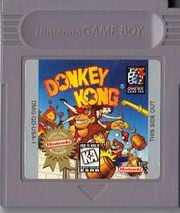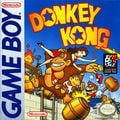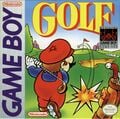Game Boy
- This article is about the game console. For the microgame of the same name in WarioWare, Inc.: Mega Microgame$!, see Game Boy (microgame). For the comic series named after the system, see Game Boy (comic).
| Game Boy | |
|---|---|

| |
| Generation | Fourth generation |
| Release date | Template:Release[?] |
| Discontinued | 2003[1] |
| Predecessor | Game & Watch |
| Successor | Virtual Boy Game Boy Color |
The Game Boy is Nintendo's second handheld console. The Game Boy is one of the best selling game systems of all time, containing a processor 2.345x faster than the Famicom and selling around 64,420,000 units worldwide (more than 118,000,000 counting the Game Boy Color). The console found enough success not to receive a successor until the Game Boy Color in 1998. It was discontinued in 2003 and is a well-known console to both Nintendo fans and collectors. It is the handheld counterpart of the NES and SNES. It has 8-bit graphics (similar to the NES). Its code name is the Dot Matrix Game, referring to the dot matrix display it had for its games, contrasting the preceding Game & Watch's pre-printed LCD display.
The Game Boy has the ,
,
, and
buttons as well as the
, which make the controls similar to that on the Famicom. In 1995, a new version of the Game Boy, as part of Nintendo's "Play It Loud!" campaign, was released. This version is exactly the same as the original; the only difference is that it was released in a wide variety of colors such as red, blue, green, and even clear. Game Boy and Game Boy Color games are also available on the Nintendo 3DS Virtual Console.
Hardware Specifications
- CPU: Z80 8-bit CMOS
- CPU Speed: 4.19 Mhz
- RAM: 8 Kbyte
- Maximum Resolution: 160 x 144 pixels
- Colors: Grayscale (four shades of gray; olive green in some cases) (in Color, they get 32,768 colors + 56 colors maximum on screen)
- Maximum sprite size: 8 x 16 pixels
- Maximum number of sprites on screen: 40 sprites, 10 per line
- Minimum/Maximum cart size: 256 Kbit - 16 Mbit
- Sound: 4 Channel
Compatibility
Below is a compatibility chart. Any game only for Game Boy Color will boot but refuse to play further. There are, however, notable color exceptions for this chart, such as Pokémon Gold and Silver Versions, which act as standard black Game Boy Color cartridges with more unorthodox cartridge colors.
| Example Cartridge | Usual Color | Game Boy mode | Compatible | |
|---|---|---|---|---|
| Original Game Boy cartridge | 
|
Gray | ||
| Game Boy Color cartridge (Black) | 
|
Black | ||
| Game Boy Color cartridge (Clear) | 
|
Clear |
Accessories
Game Link Cable
There is a Game Link Cable accessory that allows for two Game Boys to connect with each other. Dr. Mario and Super Mario Bros. Deluxe are examples of such games to take advantage of this feature. A 4-player version of the accessory exists for games that can take advantage of this accessory. Not to be confused with Game Boy Advance's method of doing so. To communicate with later models, such as the Game Boy Pocket or Game Boy Color, a special adapter needs to be used (model MGB-004).
Game Boy Camera
- Main article: Game Boy Camera
This accessory transforms the Game Boy into a very primitive monochrome digital camera.
Game Boy Printer
This accessory allows the ability to make prints of images on special thermal paper. Game Boy Printer connects to the Game Boy via Game Link Cable. The main accessory to use this accessory was the Game Boy Camera. A select few other games make use of this feature, such as Pokémon Yellow Version and the Generation II Pokémon games.
GB Memory Cartridge
- Main article: Nintendo Power (cartridge)
Only in Japan, the GB Memory Cartridge is a rewritable version of regular cartridges, through kiosks at retail stores between 1997-2007.
Remodels
Super Game Boy
- Main article: Super Game Boy
The Super Game Boy is not an actual system; rather, it is a Super Nintendo cartridge that one could insert Game Boy cartridges into, thus enabling people to play Game Boy games on their television screens through the Super Nintendo. Certain games have additional colors that can only be seen while played on a Super Game Boy. Donkey Kong has a special color palette designed for the Super Game Boy, as well as a special border designed to resemble the original arcade cabinet. Game Boy Color games with black cartridges can be played on the Super Game Boy. These features are not available on the 3DS versions due to using a Game Boy emulator rather then a SNES emulator.
Game Boy Pocket
The Game Boy Pocket is the second system of the Game Boy line. As the name implies, it is a pocket-sized Game Boy with its same features, and it was lighter in weight, with a clearer, more monochrome screen and a longer battery life. It requires two AAA batteries rather than four AA batteries in order to play games. The first release had no battery light indicator and it was rapidly replaced with a second release with the battery light due to customer complaints. The second release made its way into markets in several different colors (red, blue, green, yellow, black, etc.). It was released on July 21, 1996.[2]
Game Boy Light
The Game Boy Light is the third system in the Game Boy line. It was released only in Japan on April 14, 1998 as Nintendo was more focused on releasing the Game Boy Color in other regions. The system is slightly bigger than a Game Boy Pocket and came only in two colors, gold and silver. Its main function, as the name implies, is the ability to produce a blue-tinted backlight in order to play games in low light conditions. There were several special editions such as the Astro Boy edition.
At the time, it was the rarest Game Boy system, only available in Japan, but due to websites, such as eBay, the system became widely available in the entire world.
It was the only Game Boy system to have a proper backlight until the release of the Game Boy Advance SP.
Successors
Appearances in the Mario franchise

In the Game Boy comics mini-series by Valiant, Game Boys acted as gateways between the Mushroom World and Earth.
The Club Nintendo comic "Wart steht unter Strom" is about Wart (actually Bowser erroneously labeled as "Wart") who is playing Game Boy. The power of the batteries expires, so Wart carelessly throws the batteries away. Mario reminds him that they should be properly disposed of in containers instead. One cover of Club Nintendo features artwork of Mario, Luigi, Princess Peach, and Bowser playing with Game Boys. It also featured Mario and Luigi playing together via the Game Link Cable on the editorial page.
In the Doors to Doom book from the Nintendo Adventure Books series, Mario and Luigi can encounter Wart, who is relaxing in his lair and playing a Game Boy, having mellowed out and become a skateboarder since his last encounter with the heroes.
In Super Mario RPG: Legend of the Seven Stars, Mario is able to buy a game from a Game Boy-playing Toad at the inn in Mushroom Kingdom.
In Luigi's Mansion, there is a Boo called Game Boo, which is probably a pun on Game Boy or its series.
In WarioWare, Inc.: Mega Microgame$!, 9-Volt has a giant Game Boy in his house. One microgame, titled "Game Boy", instructs the player to insert a Game Pak into a Game Boy.
In Paper Mario: The Thousand-Year Door, there is an oversized Game Boy as the scoreboard in the Pianta Parlor.
In WarioWare: Smooth Moves, a Game Boy appears in Level 2 of the microgame Sifty Character.
In NES Remix and NES Remix 2, Some Remix and Bonus stages have the graphics switch between normal graphics and a filter with white background and black sprites, similar to the Game Boy. The sound will also be muffled when the filter is applied, similar to the Game Boy sound as well.
A stage that takes place in a Game Boy system, Dream Land GB (based on Kirby's Dream Land), appears in Super Smash Bros. for Nintendo 3DS and Super Smash Bros. Ultimate. Additionally, during the Classic mode credits minigame, hitting the Nintendo logo towards the end plays the Game Boy start-up sound.
Though the Game Boy itself doesn't appear in Super Mario Odyssey, one of the filters that is available for use in Snapshot Mode is the graphics style of the Game Boy.
In WarioWare Gold, a Game Boy appears as a souvenir. It is accompanied by the description, "Unlike Game & Watch, the Game Boy used an idea from Famicom: changing games by swapping cartridges. It also used batteries—extras were handy!"
In WarioWare: Get It Together!, a Game Boy poster can be seen in 9-Volt's bedroom. In his level, Nintendo Classics, the boss that appears in the intermission before the boss microgame carries a shield with a Game Boy design.
Gallery
System gallery
- GBPIL x16.png
Eight of the "Play It Loud!" Game Boys
Pocket Camera played on the Game Boy Pocket
Game Boy Nintendo Player's Guide
Game gallery
Miscellaneous
External links
- Nintendo Gateway System (Wikipedia) – Versions of Nintendo systems, including the Game Boy, specialized for airlines and hotels
Trivia
- To commemorate the 100th issue of Nintendo Power, an exclusive golden Game Boy Pocket with a Nintendo Power logo and a 100 next to the system's logo was bundled with the issue.
- This is the first Nintendo console that can play some of its successor's games, albeit in gray-scale.
- The screen color on the original Game Boy (lime-green palette) is later used as an alternate costume for Mr. Game & Watch in Super Smash Bros. Brawl, Super Smash Bros. for Nintendo 3DS / Wii U and Super Smash Bros. Ultimate.
- The Game Boy's startup sound can be heard in Nintendo Puzzle Collection while playing Yoshi's Cookie. It is heard when a lightbulb appears over Mario's head.
References
- ^ Nintendo. Consolidated Sales Transition by Region. Nintendo.com. Retrieved March 5, 2020.
- ^ Minotti, Mike (April 21, 2014). 25 years of the Game Boy: A timeline of the systems, accessories, and games. VentureBeat. Retrieved March 5, 2020.
| Game Boy games | |
|---|---|
| Super Mario franchise | Alleyway (1989) • Baseball (1989) • Super Mario Land (1989) • Golf (1989) • Dr. Mario (1990) • Super Mario Land 2: 6 Golden Coins (1992) • Donkey Kong (1994) • Mario's Picross (1995) • Picross 2 (1996) |
| Donkey Kong franchise | Donkey Kong (1994) • Donkey Kong Land (1995) • Donkey Kong Land 2 (1996) • Donkey Kong Land III (1997) |
| Yoshi franchise | Yoshi (1991) • Yoshi's Cookie (1992) • Tetris Attack (1996) |
| Wario franchise | Wario Land: Super Mario Land 3 (1994) • Wario Blast: Featuring Bomberman! (1994) • Wario Land II (1998) |
| Miscellaneous | Tetris (1989) • The Legend of Zelda: Link's Awakening (1993) • Game & Watch Gallery (1997) • Game & Watch Gallery 2 (1997) |








































